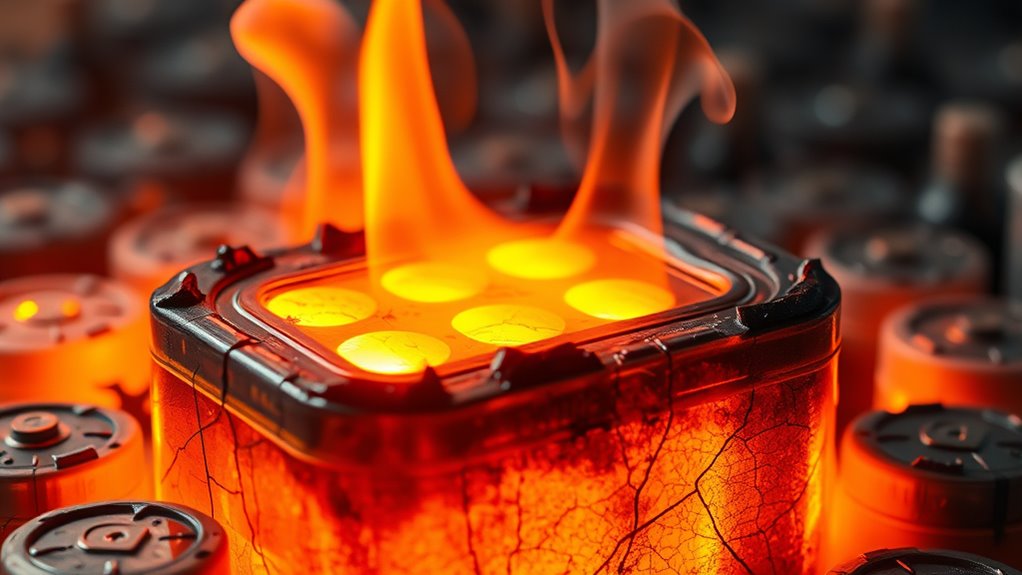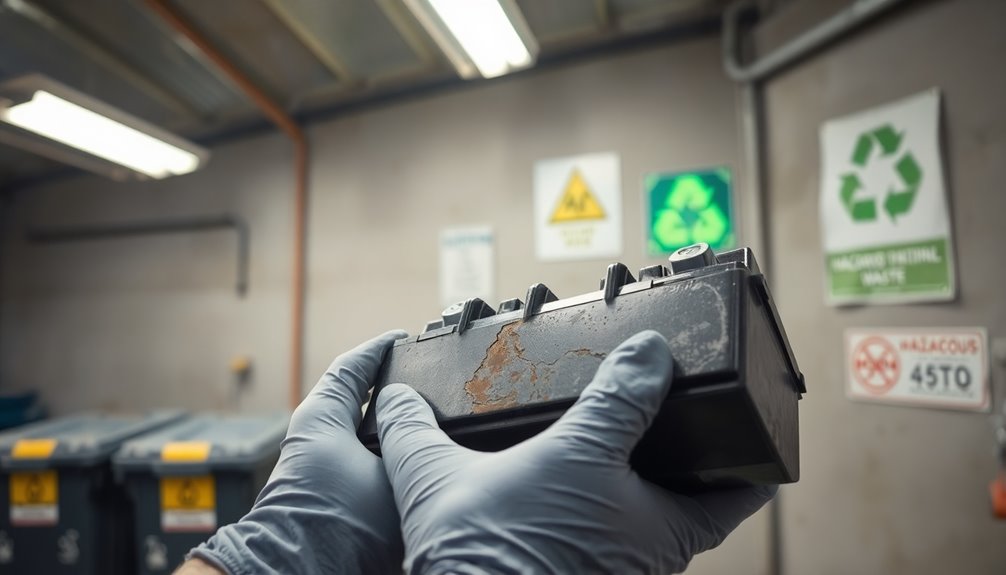When a single battery cell malfunctions, it can trigger thermal runaway, a chain reaction that causes intense heat buildup. Damage or defects create internal shorts, breaking down separator materials and accelerating chemical reactions. This leads to rapid heating, vaporizing the electrolyte, and increasing internal pressure. If safety features fail, flames and gases spread quickly, igniting the entire pack. To understand how this dangerous chain reaction starts and spreads, keep exploring the underlying causes and safety measures involved.
Key Takeaways
- A malfunctioning cell initiates a thermal runaway, generating excessive heat that can spread to neighboring cells.
- Internal damage or defects cause shorts, disrupting chemical stability and triggering self-sustaining reactions.
- Excessive heat vaporizes electrolyte, increasing pressure and risking rupture or ignition of the entire battery pack.
- Venting mechanisms may release flammable gases, which can ignite if ignited by heat or sparks.
- Safety features or improper handling can fail to contain the initial cell’s failure, allowing the fire to propagate throughout the pack.

Have you ever wondered what causes a battery or electronic device to suddenly overheat and catch fire? The answer often lies in the complex interplay of battery chemistry and the way energy is stored and released inside the cells. When a single cell begins to malfunction, it can trigger a chain reaction known as thermal runaway, which can ignite the entire battery pack. Understanding this process is essential, especially as devices become more powerful and energy-dense. Battery chemistry plays a key role in this phenomenon. Most modern rechargeable batteries, like lithium-ion cells, rely on chemical reactions to generate power. These reactions, under normal conditions, are stable and controlled. However, if a cell experiences damage, manufacturing defects, or improper handling, it can lead to internal shorts or the breakdown of separator materials. Once the internal structure is compromised, the chemical reactions can accelerate uncontrollably, producing excessive heat. This heat, in turn, causes the electrolyte to vaporize and expand, further damaging the cell and potentially igniting the flammable materials inside. The delicate balance maintained by the chemistry inside each cell is essential; once disturbed, it can escalate rapidly. Proper safety measures, such as the inclusion of thermal fuses and venting mechanisms, are designed to contain or disconnect failing cells before catastrophic failure occurs. To prevent such disasters, strict safety protocols are fundamental. Manufacturers implement rigorous testing and quality controls to identify defective cells before they reach consumers. During production, safety measures like protective circuits, venting mechanisms, and thermal fuses are integrated to contain or disconnect failing cells. As a user, you should always follow safety guidelines—avoid puncturing or crushing batteries, don’t expose them to extreme temperatures, and only use chargers that meet specifications. Proper storage and handling markedly reduce the risk of internal damage that could lead to thermal runaway. When a single cell begins to overheat, it can emit gases and increase pressure within the pack. If the safety protocols aren’t in place or fail, this pressure can cause the cell to rupture or ignite. The heat and flames can then spread to neighboring cells, creating a domino effect that rapidly engulfs the entire battery pack. This is why understanding the chemistry behind batteries and adhering to safety protocols isn’t just about prolonging device life—it’s about preventing catastrophic failures that can cause injuries or property damage. In essence, thermal runaway is a stark reminder of the importance of careful design, manufacturing, and user practices. Recognizing how sensitive battery chemistry is and respecting safety protocols can make the difference between a safe device and a dangerous hazard. Your awareness and proper handling are the final line of defense against these potentially deadly incidents.
Frequently Asked Questions
How Can Early Signs of Thermal Runaway Be Detected in Batteries?
You can detect early signs of thermal runaway by monitoring thermal indicators and temperature sensors in your batteries. Look for unusual temperature increases or fluctuations that deviate from normal operation. Regularly check sensor readings, especially during charging and discharging cycles. If you notice a sudden rise in temperature or inconsistent thermal indicators, act immediately. Early detection helps prevent a small issue from escalating into a dangerous thermal event.
What Safety Measures Prevent Thermal Runaway in Large Battery Packs?
You might worry that large battery packs are unsafe, but proper safety measures prevent thermal runaway. You should focus on effective thermal management systems that regulate temperature and avoid hotspots. Implementing strict safety protocols, like regular monitoring, fail-safes, and venting mechanisms, guarantees the pack stays safe. These precautions work together to minimize risks, keeping your batteries reliable and reducing the chance of a thermal runaway event.
Are Certain Battery Chemistries More Prone to Thermal Runaway?
Some battery chemistries are more prone to thermal runaway because of their inherent thermal stability. For example, lithium-ion chemistries like lithium cobalt oxide tend to be less thermally stable than lithium iron phosphate, which offers better safety. You should consider the chemistry’s thermal stability when choosing batteries, especially for high-demand applications. Selecting more stable chemistries reduces the risk of thermal runaway and enhances overall safety.
How Does Thermal Runaway Impact Battery Lifespan?
Like a ticking time bomb, thermal runaway accelerates cell degradation, dramatically impacting your battery’s lifespan. When a cell overheats, it accelerates capacity loss and damages nearby cells, creating a domino effect. This process shortens your battery’s overall life, making it less reliable and efficient. Essentially, thermal runaway hastens the decline of your battery, turning what once held power into a shadow of its former self, decreasing performance over time.
Can Thermal Runaway Occur in Non-Chemical Energy Storage Systems?
You might wonder if thermal runaway can happen in non-chemical energy storage systems. While it’s primarily a chemical process, similar risks exist in alternative energy systems like mechanical failure in flywheels or compressed air storage. These failures can lead to overheating or explosions, resembling thermal runaway. So, even without chemical reactions, energy storage systems face safety risks from mechanical issues that could cause rapid energy release or fires.
Conclusion
Imagine if one faulty cell in your battery ignites a fire that spreads uncontrollably. It’s tempting to think a single cell can’t cause such destruction, but history shows otherwise. Thermal runaway proves that a tiny flaw can trigger a catastrophic chain reaction, devastating everything in its path. Don’t underestimate the power of one small failure — it could ignite a disaster you never saw coming. Stay vigilant, because sometimes, the smallest spark leads to the biggest blaze.










